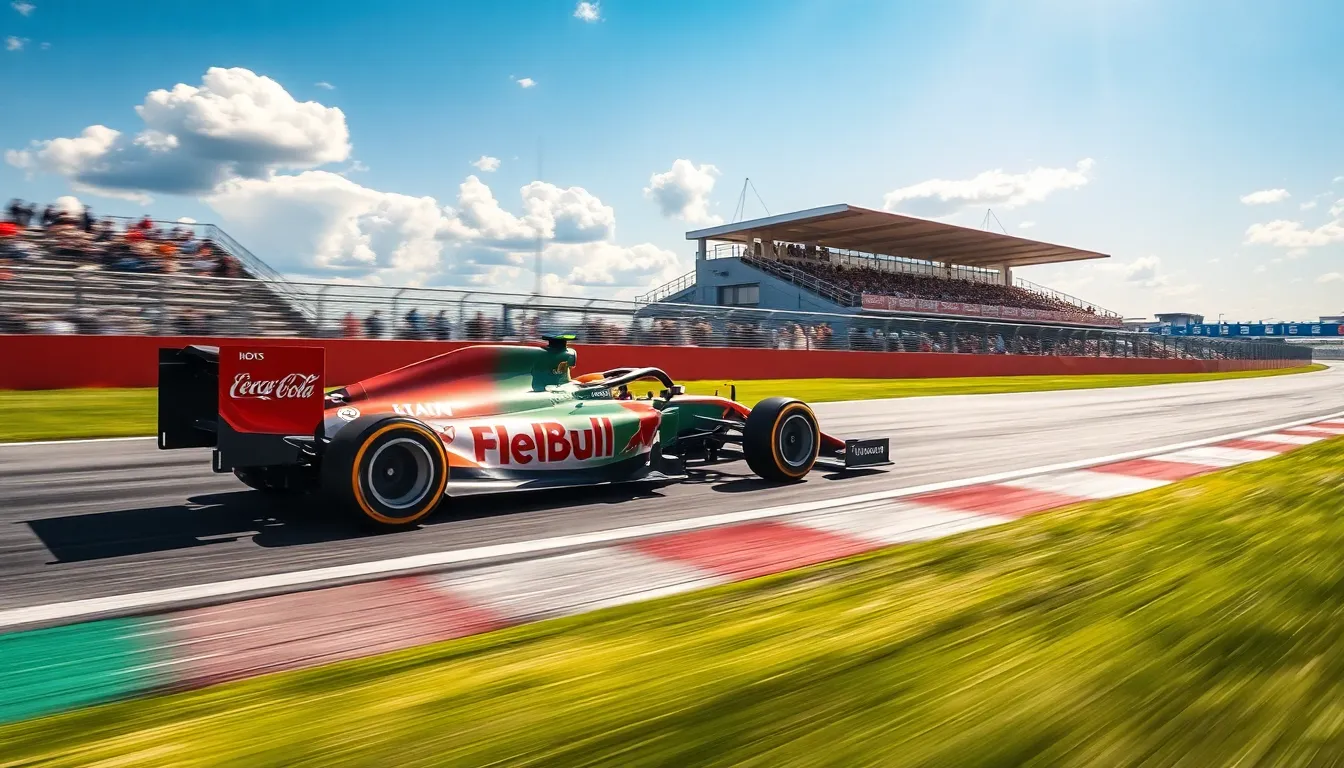The thunderous roar of engines and the blur of aerodynamic bodies streaking past at incredible speeds – that’s the heart-pounding industry of race cars we’re diving into. These engineering marvels represent the pinnacle of automotive performance where every component is meticulously designed for one purpose: winning.
We’ve all felt that rush watching Formula 1 cars navigate hairpin turns at breakneck speeds or witnessed NASCAR vehicles draft mere inches apart at 200+ mph. But there’s so much more beneath the surface of these speed demons that makes them truly fascinating.
From cutting-edge aerodynamics to revolutionary safety innovations that eventually find their way into our everyday vehicles race cars aren’t just about entertainment – they’re laboratories on wheels. Whether you’re a casual motorsports fan or someone considering the racing industry we’ll explore what makes these machines so extraordinary and why they continue to captivate millions of enthusiasts worldwide.
History of Race Cars: From Early Pioneers to Modern Marvels
Racing’s rich heritage spans over a century of innovation and passion. We’ve witnessed automotive competition evolve from crude horseless carriages to sophisticated technological masterpieces that push the boundaries of human engineering.
The Birth of Automobile Racing in the Late 1800s
Organized racing began in 1894 with the Paris-Rouen competition, marking the first official automobile race in history. We saw 25 brave drivers navigate 79 miles of rough French roads in steam-powered and gasoline-fueled machines that barely exceeded 12 mph.
European pioneers established racing circuits throughout the 1890s, creating events like the Gordon Bennett Cup in 1900. We witnessed manufacturers like Peugeot, Panhard, and Daimler compete fiercely to prove their automotive superiority on primitive racetracks carved from public roads.
American racing culture emerged with the 1896 Chicago Times-Herald race, where only 6 of 83 registered vehicles actually started. We observed early American innovators like the Duryea brothers demonstrate that motorsport could captivate audiences and drive technological advancement simultaneously.
Evolution of Race Car Design Through the Decades
Aerodynamic understanding revolutionized car design in the 1960s, introducing wings and spoilers that dramatically improved performance. We tracked how Formula 1 teams began incorporating aircraft engineering principles, reducing lap times by 15-20 seconds at major circuits like Monza and Silverstone.
Safety innovations transformed racing vehicles throughout the 1970s and 1980s, following tragic accidents that claimed drivers’ lives. We implemented roll cages, fire suppression systems, and HANS devices that reduced fatal injuries by over 85% according to FIA statistics.
Computer technology enhanced race car development starting in the 1990s, allowing teams to simulate thousands of design variations. We utilized wind tunnels, telemetry data, and computational fluid dynamics to create machines capable of generating over 3,000 pounds of downforce at racing speeds.
Modern race cars incorporate carbon fiber construction and hybrid powertrains, representing the pinnacle of automotive engineering. We’ve seen Formula 1 cars achieve thermal efficiency rates exceeding 50%, surpassing most road car engines by important margins.
Milestone Moments That Shaped Racing History
| Year | Event | Impact |
|---|---|---|
| 1911 | First Indianapolis 500 | Established America’s greatest race |
| 1950 | Formula 1 Industry Championship begins | Created global racing standardization |
| 1959 | NASCAR’s first Daytona 500 | Launched stock car racing’s premier event |
| 1966 | Ford defeats Ferrari at Le Mans | Proved American engineering could dominate |
| 1988 | McLaren’s perfect F1 season | Set the standard for team excellence |
Jackie Stewart’s safety crusade in the late 1960s fundamentally changed racing culture, transforming motorsport from a deadly spectacle into a professional sport. We credit his advocacy with reducing driver fatalities from 12 per year in the 1960s to fewer than 2 annually by the 1980s.
Ground effect aerodynamics emerged in 1977 with the Lotus 78, creating cars that literally sucked themselves to the track surface. We witnessed lap times drop dramatically as teams mastered this revolutionary technology, though it was eventually banned due to extreme cornering forces that stressed drivers beyond safe limits.
The introduction of electronic systems in the 1980s marked racing’s digital age, bringing anti-lock brakes, traction control, and active suspension. We saw these innovations trickle down to consumer vehicles, proving that racing truly serves as our laboratory for automotive advancement.
Types of Race Cars: Understanding Different Racing Categories
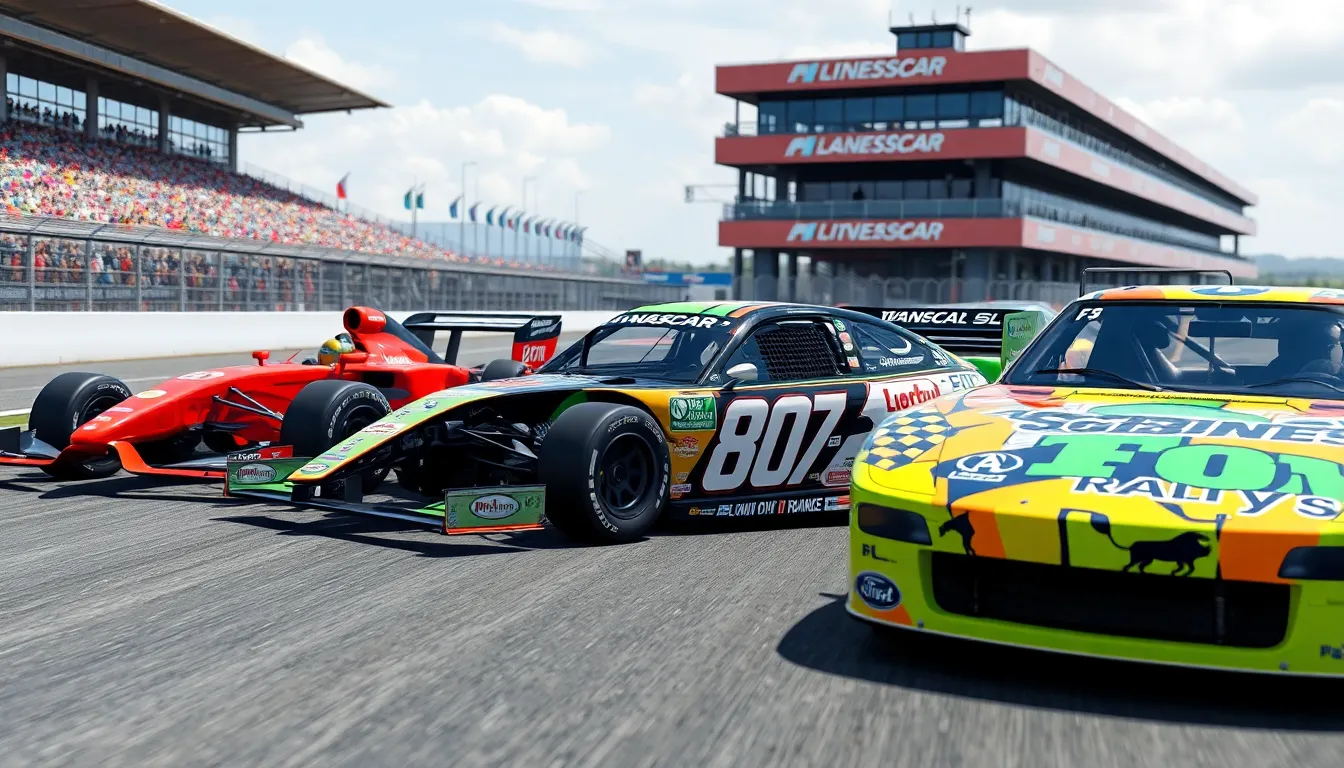
Each racing category features specialized vehicles designed for exact challenges and track conditions. We’ll explore the most prominent types of race cars that dominate motorsports worldwide.
Formula One: The Pinnacle of Open-Wheel Racing
Formula One cars represent the ultimate expression of automotive engineering and aerodynamic innovation. These single-seat machines generate over 1,000 horsepower from their 1.6-liter V6 hybrid power units while weighing just 1,760 pounds including the driver.
Open-wheel design maximizes airflow efficiency around the vehicle, creating downforce levels that could theoretically drive the car upside down at speeds above 120 mph. Advanced materials like carbon fiber monocoques provide exceptional strength while maintaining minimal weight, allowing drivers to experience forces up to 6G during cornering.
Modern F1 cars feature complex aerodynamic packages with front wings, rear wings, and floor channels that manipulate airflow to optimize performance. Teams spend over $400 million annually developing these technological marvels, making Formula One the most expensive form of motorsport globally.
NASCAR: Stock Car Racing at Its Finest
NASCAR Cup Series cars evolved from modified street vehicles into purpose-built racing machines designed for high-speed oval competition. These 3,400-pound stock cars produce approximately 670 horsepower from naturally aspirated V8 engines, reaching speeds exceeding 200 mph on superspeedways.
Aerodynamic elements like front splitters and rear spoilers create crucial downforce for stability during close-quarters racing at tracks like Daytona and Talladega. Safety innovations including steel roll cages, impact-absorbing barriers, and HANS devices protect drivers during the inevitable contact that defines stock car racing.
Current Next Gen cars feature independent rear suspension, larger wheels, and composite body panels that reduce costs while maintaining competitive balance across all manufacturers including Chevrolet, Ford, and Toyota.
IndyCar: High-Speed Oval and Road Course Champions
IndyCar series vehicles combine the open-wheel design of Formula One with the high-speed capabilities needed for American oval racing. These 1,630-pound machines use 2.2-liter twin-turbocharged V6 engines producing around 700 horsepower, depending on boost levels set for different track types.
Versatility defines IndyCar racing, with teams adjusting aerodynamic configurations between superspeedways like Indianapolis Motor Speedway and road courses such as Watkins Glen. Universal aero kits ensure competitive parity while allowing teams to fine-tune setups for exact track characteristics.
Safety improvements include advanced cockpit protection systems and energy-absorbing crash structures that have significantly reduced injury rates since implementation. Drivers compete on 17 different circuits annually, showcasing their adaptability across diverse racing environments.
Rally Cars: Built for All-Terrain Racing
Rally cars tackle the most demanding racing conditions, from snow-covered forests to desert dunes, requiring specialized all-wheel-drive systems and robust suspension components. These modified production vehicles generate between 300-380 horsepower while maintaining reliability across hundreds of miles of challenging terrain.
Advanced traction control systems and differential locks help drivers navigate surfaces including gravel, tarmac, ice, and mud during events like the Industry Rally Championship. Reinforced chassis structures, roll cages, and skid plates protect vital components from rocks, jumps, and impacts with natural obstacles.
Co-drivers play essential roles in rally racing, providing pace notes that describe upcoming corners, hazards, and surface changes at speeds often exceeding 100 mph through unmarked forest roads. Teams must complete service intervals with limited mechanical support, emphasizing durability alongside performance.
Drag Racing Cars: Quarter-Mile Speed Demons
Drag racing cars focus exclusively on straight-line acceleration over quarter-mile distances, with Top Fuel dragsters achieving 0-100 mph times under one second. These specialized machines produce over 11,000 horsepower from supercharged nitromethane-fueled engines, reaching terminal speeds above 330 mph.
Massive rear tires measuring 36 inches tall provide the grip necessary to transfer enormous power to the track surface, while parachutes deploy at the finish line to assist with deceleration. Lightweight construction using materials like carbon fiber and magnesium reduces overall weight to approximately 2,300 pounds even though powerful drivetrain components.
Pro Stock cars offer a more relatable category, using naturally aspirated V8 engines producing around 1,400 horsepower in vehicles resembling production muscle cars. These classes demonstrate pure acceleration performance, with races decided by thousandths of seconds over the traditional quarter-mile distance.
Engine Technology in Race Cars: Power and Performance
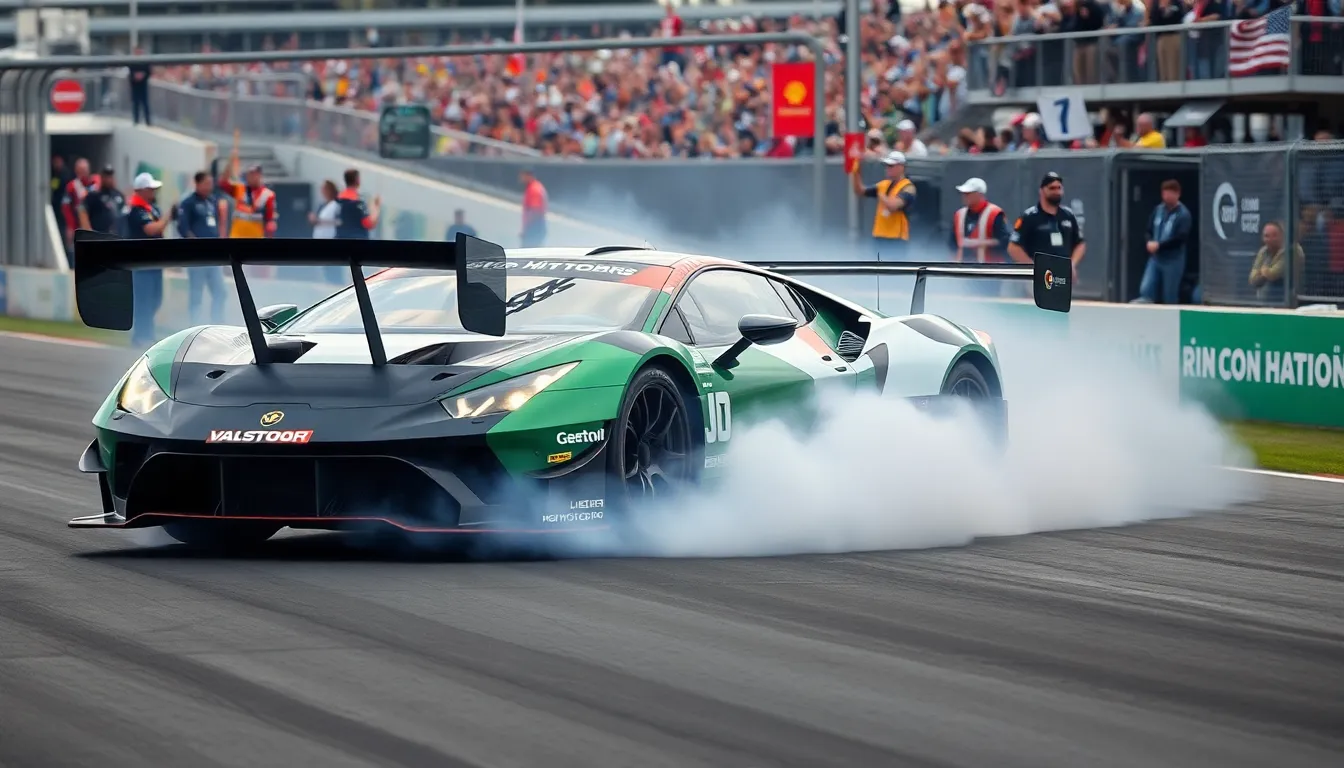
The heart of every race car lies in its powertrain technology, where engineering precision meets raw performance demands. Modern racing has witnessed a dramatic shift from traditional combustion engines to innovative hybrid and electric systems that redefine speed and efficiency.
Internal Combustion Engines vs. Electric Powertrains
Traditional internal combustion engines continue dominating most racing categories, delivering the thunderous roar and immediate throttle response that defines motorsport. Formula 1 cars use 1.6-liter V6 turbocharged engines that produce over 1,000 horsepower when combined with their hybrid systems, showcasing how conventional powertrains evolve with electric assistance.
Electric powertrains are rapidly gaining ground in racing, particularly in Formula E where single-seater cars reach speeds of 200 mph using only battery power. Tesla’s Model S Plaid demonstrates electric racing potential by achieving 0-60 mph in under 2 seconds, proving that instant torque delivery gives electric motors a important acceleration advantage over combustion engines.
| Engine Type | Power Output | 0-60 mph Time | Top Speed |
|---|---|---|---|
| F1 Hybrid V6 | 1,000+ hp | 2.6 seconds | 230+ mph |
| Formula E | 335 hp | 2.8 seconds | 200 mph |
| NASCAR V8 | 750 hp | 3.4 seconds | 200 mph |
Hybrid systems combine both technologies, allowing race cars to harvest energy during braking and deploy it for additional power bursts. IndyCar’s hybrid system adds 60 horsepower for 33.3 seconds per lap, creating strategic opportunities for overtaking and fuel saving that weren’t possible with purely combustion-based powertrains.
Turbocharging and Supercharging Systems
Turbocharging technology forces more air into engine cylinders by using exhaust gases to spin a turbine, dramatically increasing power output without adding important weight. Modern F1 engines achieve remarkable efficiency through sophisticated turbocharger designs that eliminate turbo lag and provide consistent power delivery across the rev range.
Supercharging systems use mechanical belt drives to compress incoming air, offering immediate throttle response that turbochargers sometimes lack. Top Fuel dragsters employ massive superchargers that consume up to 900 horsepower just to operate, but they generate over 11,000 total horsepower for those crucial quarter-mile runs.
Variable geometry turbochargers adjust their internal components based on engine speed and load, optimizing performance across different racing conditions. Rally cars particularly benefit from this technology because they encounter varying altitudes and weather conditions that affect air density and engine performance throughout a single event.
Twin-turbo setups use two smaller turbochargers instead of one large unit, reducing lag time and improving power distribution. Porsche’s endurance racing engines demonstrate how twin-turbo configurations provide both peak power and the reliability needed for 24-hour races like Le Mans.
Fuel Types and Their Impact on Performance
High-octane racing fuels allow engines to run higher compression ratios and more aggressive timing without knocking, directly translating to increased power output. Formula 1 uses specialized unleaded fuel with 102 octane rating, while Top Fuel dragsters burn nitromethane that contains its own oxygen supply for extreme combustion efficiency.
Ethanol-based fuels like E85 provide cooling benefits and resist detonation better than traditional gasoline, enabling IndyCar engines to produce more power while running leaner air-fuel mixtures. NASCAR’s switch to Sunoco Green E15 demonstrates how racing drives innovation in sustainable fuel technologies that eventually benefit consumer vehicles.
Aviation gas (100LL) offers consistency and high octane ratings that make it popular in amateur racing categories, though its lead content requires special handling procedures. Many grassroots racing series specify pump gas to control costs, proving that engine tuning expertise can extract impressive performance from readily available fuels.
Methanol burns cooler than gasoline and allows for higher compression ratios, making it the fuel of choice for sprint cars and dirt track racing where engine durability under extreme conditions is crucial. Its lower energy density requires larger fuel tanks, but the power gains and engine protection benefits often outweigh this disadvantage in sprint racing formats.
Aerodynamics and Race Car Design: Cutting Through the Air

Aerodynamic efficiency separates championship contenders from the rest of the field in modern motorsports. Advanced airflow management transforms race cars into precision instruments that slice through air resistance while generating crucial downforce.
Wing Design and Downforce Generation
Wings generate downforce by creating differential air pressure above and below their surfaces. Formula 1 cars produce up to 1,500 pounds of downforce at 180 mph, effectively pressing the vehicle into the track surface with tremendous force. Front wings typically feature multiple adjustable elements that direct airflow around the front wheels while creating initial downforce for enhanced steering response.
Rear wings work along with front wings to balance the car’s aerodynamic load distribution. NASCAR vehicles use large rear spoilers that generate approximately 400 pounds of downforce at racing speeds, providing stability through high-speed turns at superspeedways like Daytona and Talladega. IndyCars employ adjustable wing systems that teams modify based on track requirements, with road course configurations featuring higher downforce settings than oval track setups.
Multi-element wing designs maximize downforce while managing drag penalties through complex airflow interactions. Each wing element creates its own vortex system that energizes the airflow over subsequent elements, allowing engineers to generate more downforce than single-element designs. Ground effect systems work alongside wing-generated downforce by accelerating air beneath the car’s floor, creating a low-pressure zone that literally suctions the vehicle to the track surface.
Body Shape Optimization for Speed
Body shape optimization focuses on minimizing drag while maintaining essential downforce characteristics. Streamlined silhouettes reduce air resistance by allowing smooth airflow attachment across the vehicle’s surfaces, with the most efficient designs featuring teardrop-inspired profiles that gradually taper toward the rear.
Front nose designs channel airflow around and over the cockpit area while feeding air to crucial cooling systems. LMP1 prototype cars demonstrate optimal body shaping with enclosed wheel designs that eliminate the drag-inducing turbulence created by exposed wheels in open-wheel categories. Side pod configurations house radiators and other cooling components while maintaining smooth airflow transition from the nose to the rear wing mounting points.
Underbody aerodynamics use carefully sculpted floor panels and diffusers that accelerate airflow beneath the car. Modern race cars feature complex undertray designs with multiple channels and vanes that manage airflow velocity and pressure distribution. Diffuser sections at the rear of the underbody gradually expand the airflow cross-sectional area, creating a venturi effect that generates important downforce while helping reduce overall drag.
Wind Tunnel Testing and Computational Fluid Dynamics
Wind tunnel testing provides real-industry validation of aerodynamic concepts through scaled model testing and full-size vehicle evaluation. Formula 1 teams operate their own wind tunnel facilities that can simulate airspeeds up to 180 mph using 60% scale models with remarkable precision. These facilities incorporate moving ground planes and rotating wheel systems that accurately replicate on-track conditions.
Computational Fluid Dynamics (CFD) modeling allows engineers to analyze millions of airflow data points across the entire vehicle surface. Advanced CFD software can process complex calculations involving turbulent airflow, heat transfer, and pressure distribution in hours rather than the weeks required for physical testing. Teams typically run thousands of CFD simulations during car development, exploring aerodynamic modifications that would be cost-prohibitive to test physically.
Integration of wind tunnel data with CFD results creates comprehensive aerodynamic development programs that optimize every surface of the race car. Modern aerodynamic development combines both testing methods, with CFD providing broad concept exploration and wind tunnel testing validating the most promising designs. Real-industry track testing then confirms that laboratory results translate to actual racing performance, completing the aerodynamic development cycle that produces today’s incredibly efficient race cars.
Safety Features in Modern Race Cars: Protecting Drivers at High Speeds
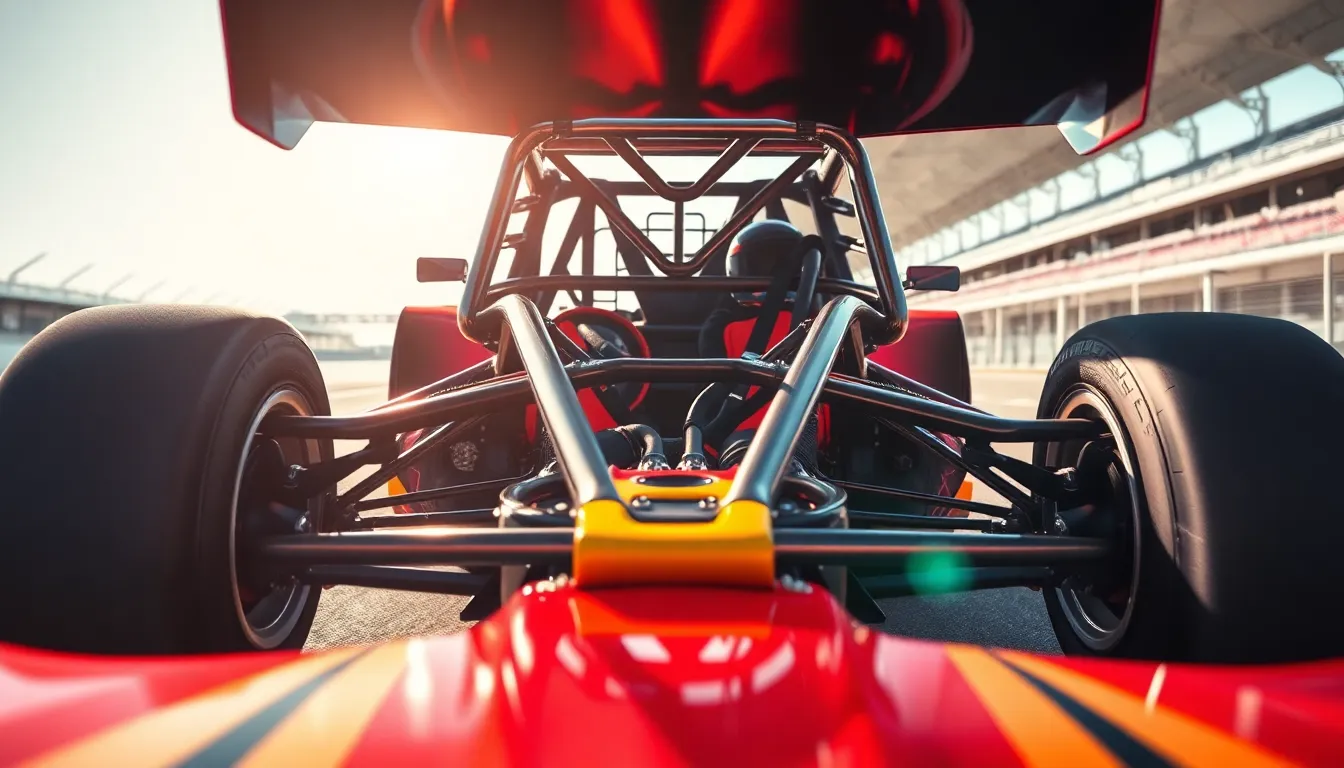
Race car safety technology has evolved dramatically over the past five decades, transforming what was once an extremely dangerous sport into a much safer try. We’ve witnessed remarkable advancements that protect drivers from the extreme forces and hazards they face at speeds exceeding 200 mph.
Roll Cages and Chassis Construction
Roll cages form the protective backbone of every modern race car, designed to maintain structural integrity during violent impacts and rollovers. NASCAR mandates multi-point roll cage systems constructed from 1.75-inch diameter steel tubing that must pass rigorous testing standards. Formula 1 cars feature carbon fiber monocoques that weigh approximately 165 pounds yet can withstand impact forces exceeding 25G.
Steel tube construction in stock cars creates a safety cell around the driver compartment, with door bars positioned to absorb side impact energy. Carbon fiber chassis designs in open wheel racing provide superior strength-to-weight ratios while incorporating crumple zones that dissipate crash energy. IndyCar chassis undergo extensive crash testing at speeds up to 140 mph to ensure driver survival in the most severe accidents.
Reinforcement structures extend throughout the entire vehicle frame, connecting the roll cage to mounting points that distribute impact forces. Safety cell designs in modern race cars create multiple load paths that redirect dangerous forces away from the driver compartment. Testing protocols require chassis to withstand impacts from multiple angles, ensuring comprehensive protection regardless of accident orientation.
Fire Suppression Systems and Safety Equipment
Fire suppression systems in race cars deploy within seconds of activation, flooding the cockpit and engine bay with flame retardant chemicals. NASCAR vehicles use AFFF (Aqueous Film Forming Foam) systems that can extinguish fuel fires in under 10 seconds. Formula 1 cars employ dual activation systems that allow both driver and track marshals to trigger fire suppression remotely.
Onboard extinguisher bottles contain pressurized suppression agents specifically designed for different fire types, including electrical and fuel-based blazes. Activation switches are positioned within easy reach of the driver’s hands, even when secured in racing harnesses. Nozzle placement throughout the cockpit ensures complete coverage of potential fire sources.
Personal protective equipment includes fire-resistant racing suits rated to withstand temperatures exceeding 1,800°F for 12 seconds. Nomex underwear, gloves, and shoes provide additional layers of protection against flash fires. Helmet designs incorporate fire-resistant materials and ventilation systems that prevent heat buildup during extended racing sessions.
HANS Device and Other Head Protection Technologies
HANS devices revolutionized driver safety by preventing basilar skull fractures, which were responsible for many racing fatalities before their introduction. We see reduction rates of over 90% in serious head and neck injuries since HANS became mandatory across major racing series. The device connects the helmet to the shoulder harness system, limiting dangerous head movement during frontal impacts.
Carbon fiber tethers in HANS systems allow normal head movement while restricting forward motion to safe parameters during crashes. Weight distribution across the shoulders prevents neck compression while maintaining driver comfort during long races. Modern HANS devices weigh less than 1.5 pounds and integrate seamlessly with existing safety harness systems.
Helmet technology now incorporates advanced impact absorption materials that reduce concussion risks by up to 40% compared to previous designs. Carbon fiber shell construction provides superior strength while reducing weight to minimize neck strain during high G-force turns. Communication systems built into helmets allow constant contact between drivers and pit crews during emergencies.
Head restraint systems complement HANS devices by providing additional lateral support during side impacts. Energy-absorbing foam padding inside helmets conforms to individual head shapes for optimal protection and comfort. Advanced ventilation systems prevent heat stress while maintaining clear visibility through anti-fog visor treatments.
Famous Race Car Drivers: Legends Behind the Wheel
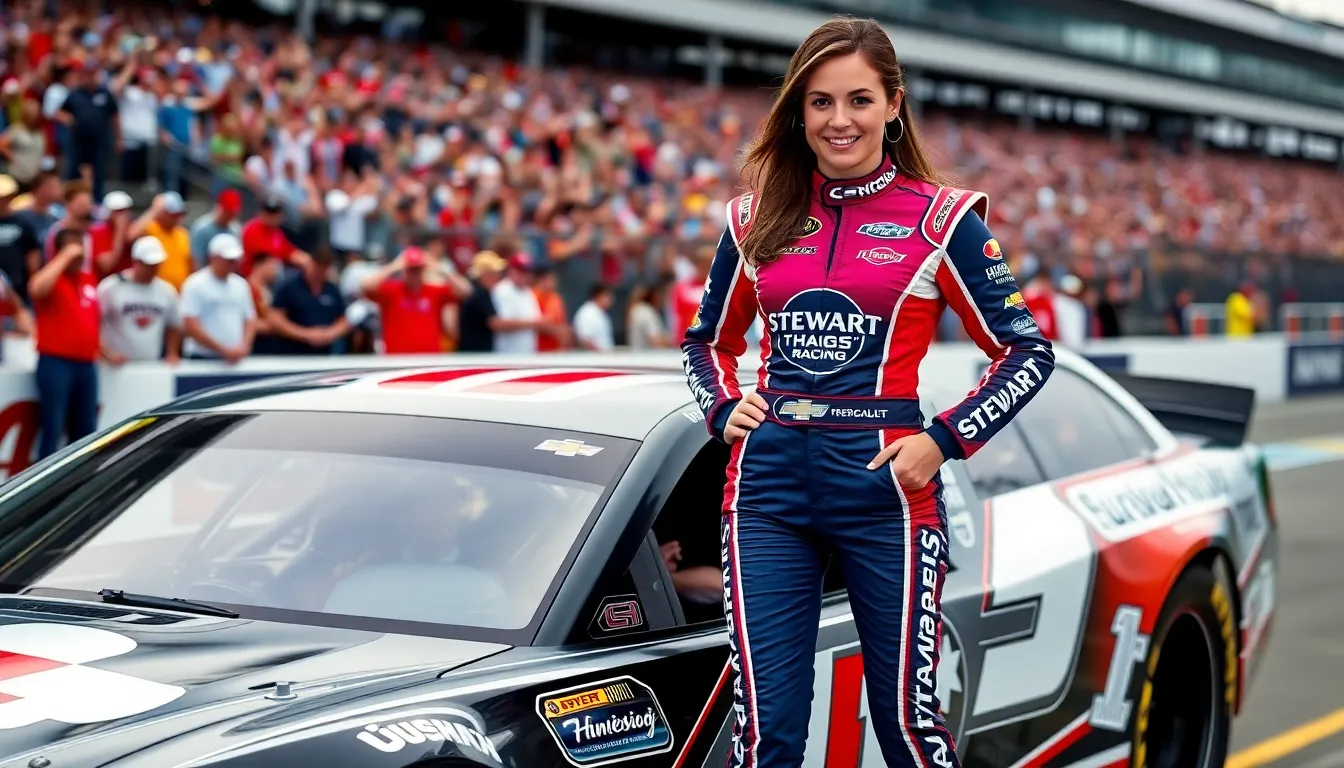
Behind every legendary race car stands an equally legendary driver who pushed these engineering marvels to their absolute limits. We’ve witnessed countless drivers transform from ambitious rookies into motorsport icons who’ve left indelible marks on racing history.
Formula One Champions and Their Iconic Machines
Ayrton Senna dominated Formula One racing during the late 1980s and early 1990s, capturing three industry championships while piloting McLaren’s revolutionary MP4/4 and MP4/6 cars. His aggressive driving style and mastery of wet weather conditions made him a legend, particularly during his 41 career victories before his tragic death at Imola in 1994.
Michael Schumacher revolutionized modern Formula One by winning seven industry championships, including five consecutive titles with Ferrari from 2000 to 2004. Racing in cars like the Ferrari F2004, Schumacher set 91 Grand Prix victory records and demonstrated unprecedented dedication to fitness and technical development that elevated the entire sport.
Lewis Hamilton has redefined excellence in the hybrid era, securing seven industry championships while racing for McLaren and Mercedes teams. Driving cars like the dominant Mercedes W11, Hamilton achieved 103 race victories and became Formula One’s most successful driver, breaking many records previously held by Schumacher.
Sebastian Vettel captured four consecutive industry championships from 2010 to 2013 while driving Red Bull’s aerodynamically superior RB19 and RB20 cars. His precise driving technique and strategic racecraft helped establish Red Bull as a dominant force during the sport’s transition to more complex aerodynamic regulations.
NASCAR Hall of Fame Drivers
Dale Earnhardt Sr. earned the nickname “The Intimidator” through his aggressive driving style and seven NASCAR Cup Series championships between 1980 and 1994. Racing primarily in Chevrolet Monte Carlos and Luminas, Earnhardt accumulated 76 career victories and became synonymous with NASCAR’s popularity surge during the 1980s and 1990s.
Richard Petty holds the record for most NASCAR Cup Series victories with 200 wins, earning seven championships while driving Plymouth and Dodge stock cars throughout his career. Known as “The King,” Petty’s success in cars like the Plymouth Road Runner and Dodge Charger helped establish NASCAR’s credibility during its formative decades.
Jeff Gordon transformed NASCAR’s image during the 1990s by attracting new fans while winning four championships in Hendrick Motorsports Chevrolets. Driving cars like the iconic rainbow colored Monte Carlo, Gordon captured 93 career victories and helped modernize NASCAR’s appeal to mainstream audiences.
Jimmie Johnson achieved unprecedented success by winning five consecutive NASCAR championships from 2006 to 2010 while driving Hendrick Motorsports Chevrolets. His partnership with crew chief Chad Knaus produced 83 career victories and established Johnson as one of NASCAR’s most consistent performers during the sport’s modern era.
Pioneering Women in Race Car Driving
Danica Patrick became the most successful woman in American open wheel racing history, winning the 2008 IndyCar Series race at Twin Ring Motegi in Japan. Transitioning to NASCAR, Patrick drove cars like the Stewart Haas Racing Chevrolet SS and achieved multiple top ten finishes while inspiring countless young women to pursue motorsports careers.
Shirley Muldowney broke barriers in drag racing by becoming the first woman to win an NHRA Top Fuel championship in 1977, eventually capturing three titles. Racing dragsters like her iconic pink “Cha Cha” car, Muldowney proved women could compete successfully in motorsports’ most physically demanding categories.
Janet Guthrie pioneered women’s participation in major American racing series by becoming the first woman to compete in both the Indianapolis 500 and Daytona 500. Driving cars like the Lightning chassis IndyCar and various NASCAR stock cars during the 1970s, Guthrie opened doors for future generations of female drivers.
Michèle Mouton achieved remarkable success in Industry Rally Championship competition, becoming the first woman to win a WRC event at the 1981 Rallye Sanremo. Racing Audi Quattro rally cars, Mouton captured four WRC victories and finished second in the 1982 industry championship, proving women could excel in motorsports’ most challenging disciplines.
Race Car Manufacturing: Building Speed Machines
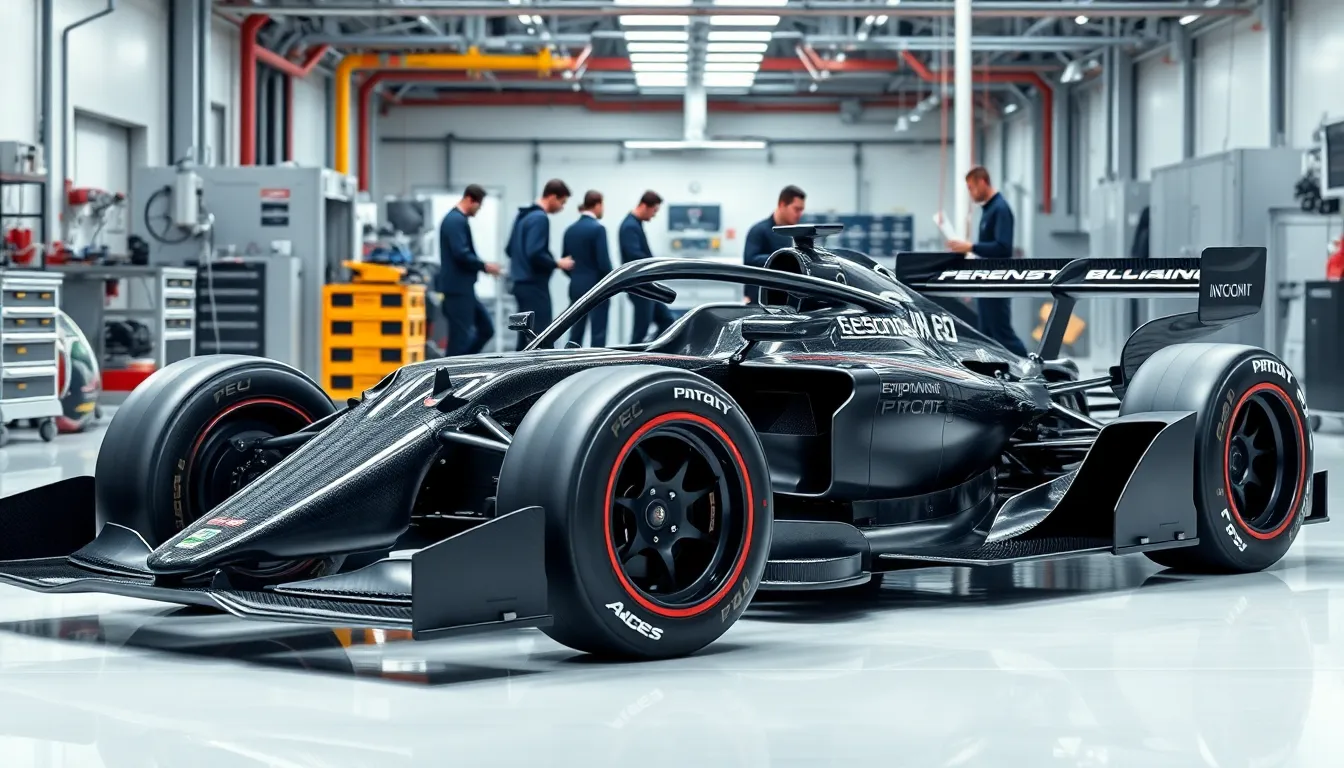
Modern race car manufacturing combines cutting edge technology with decades of engineering expertise to create vehicles that push the boundaries of speed and performance. We’re witnessing an era where precision manufacturing meets innovative design to produce some of the most advanced machines ever built.
Leading Race Car Manufacturers and Teams
McLaren stands as one of the most prestigious manufacturers in Formula 1, having produced championship winning cars for over five decades. Their Surrey based facility combines aerospace grade carbon fiber construction with advanced manufacturing techniques that create vehicles capable of reaching speeds exceeding 230 mph.
Mercedes AMG Petronas dominates modern Formula 1 manufacturing through their Brackley headquarters, where engineers use wind tunnels and computational fluid dynamics to create aerodynamically superior machines. Ferrari continues its legendary Italian craftsmanship at their Maranello facility, where each car represents decades of racing heritage combined with contemporary technology.
Hendrick Motorsports leads NASCAR manufacturing from their Charlotte facility, building stock cars that compete at speeds over 200 mph on superspeedways. Team Penske operates multiple manufacturing divisions that produce IndyCar chassis and NASCAR vehicles, demonstrating versatility across different racing categories.
Dallara specializes in open wheel race car construction, manufacturing IndyCar chassis used by all teams in the series since 2012. Their Italian facility produces approximately 30 IndyCar chassis annually, each featuring carbon fiber monocoque construction designed to withstand impacts exceeding 100 Gs.
Cost of Building Professional Race Cars
Formula 1 cars command the highest manufacturing costs in motorsports, with each chassis costing between $15 million and $20 million to develop and build. Mercedes and Ferrari invest over $400 million annually in their Formula 1 programs, including research and development expenses.
NASCAR Cup Series cars cost approximately $400,000 to $500,000 per chassis, with teams typically maintaining 15 to 20 cars throughout a season. IndyCar chassis purchased from Dallara cost teams around $349,000, though teams spend additional hundreds of thousands on setup components and aerodynamic packages.
Rally cars built for Industry Rally Championship competition cost between $1 million and $1.5 million each, incorporating specialized all wheel drive systems and reinforced safety cages. Top fuel dragsters require investments of $300,000 to $500,000, featuring engines that produce over 11,000 horsepower and consume 15 gallons of nitromethane per quarter mile run.
| Racing Category | Base Cost | Annual Team Budget | Key Components |
|---|---|---|---|
| Formula 1 | $15-20M | $300-400M | Carbon fiber chassis, hybrid power unit |
| NASCAR | $400-500K | $15-20M | Steel tube frame, V8 engine |
| IndyCar | $349K | $8-12M | Carbon fiber monocoque, twin turbo V6 |
| WRC Rally | $1-1.5M | $25-30M | AWD system, reinforced chassis |
Custom vs. Production Based Race Cars
Custom built race cars dominate the highest levels of motorsports, where manufacturers create purpose built machines from the ground up. Formula 1 teams design and manufacture every component specifically for racing, resulting in vehicles that share no parts with road cars and achieve cornering forces exceeding 5 Gs.
Production based race cars start with existing road vehicles and modify them extensively for competition. NASCAR Cup Series cars use production based body panels from manufacturers like Chevrolet, Ford, and Toyota, though the underlying chassis and drivetrain components are purpose built for racing.
GT racing represents a middle ground approach, where manufacturers like Porsche, Ferrari, and Aston Martin create race versions of their production supercars. These vehicles maintain visual similarity to their road counterparts while incorporating racing exact aerodynamics, roll cages, and stripped interiors that reduce weight by over 1,000 pounds.
Touring car racing utilizes heavily modified production vehicles, where teams start with factory shells and install custom racing components. British Touring Car Championship competitors transform road cars into race machines capable of producing 350 horsepower while maintaining recognizable exterior styling that connects with fans.
Club racing often features modified production cars that balance performance with affordability, allowing privateer teams to compete with budgets under $100,000. These grassroots efforts demonstrate how production based platforms can be transformed into capable race cars without the massive investments required for custom built machines.
Future of Race Cars: Innovation and Sustainability
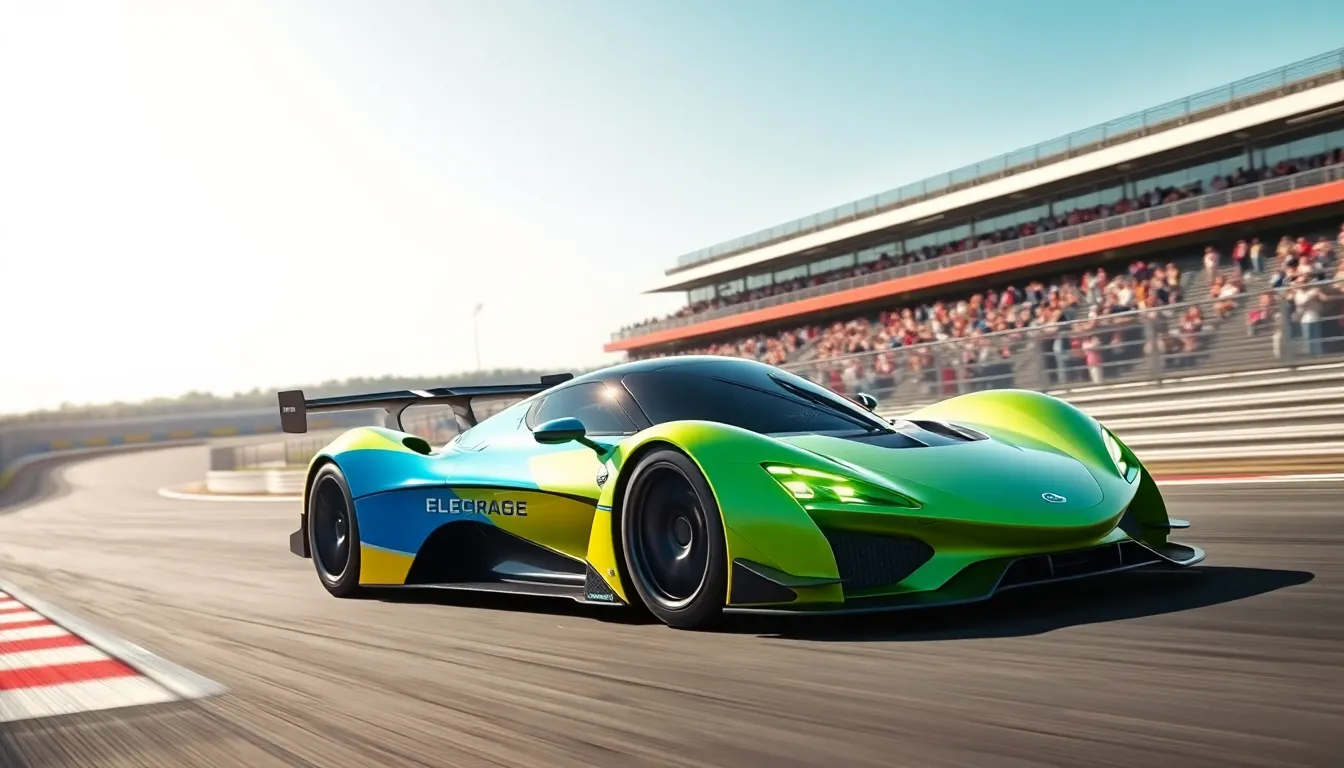
Racing continues to evolve as manufacturers embrace cutting-edge technologies that prioritize both performance and environmental responsibility. We’re witnessing a groundbreaking period where traditional motorsports adapt to modern demands for cleaner, more efficient racing answers.
Electric Race Cars and Formula E
Electric powertrains are revolutionizing motorsport through Formula E, which launched in 2014 as the industry’s first fully electric racing series. Formula E cars generate 335 horsepower from their battery-powered systems and accelerate from 0 to 60 mph in just 2.8 seconds, proving electric vehicles can deliver thrilling performance.
Battery technology advances have enabled Formula E cars to complete entire races without mid-race car swaps, a requirement eliminated in the 2018-19 season. Current Formula E vehicles achieve top speeds of 174 mph while maintaining consistent power delivery throughout 45-minute race sessions.
Racing teams are developing regenerative braking systems that recover up to 250 kW of energy during deceleration, extending range and improving efficiency. These innovations directly transfer to consumer electric vehicles, with manufacturers like Audi, Mercedes, and Porsche using Formula E as testing grounds for road car technology.
| Electric Racing Specification | Formula E Gen3 | Consumer Impact |
|---|---|---|
| Power Output | 470 kW (630 hp) | Advanced motor efficiency |
| Top Speed | 200+ mph | High-performance EVs |
| Battery Capacity | 51 kWh | Fast-charging technology |
| Weight | 1,804 lbs | Lightweight construction |
Autonomous Racing Technology
Autonomous racing represents the next frontier in motorsport innovation, with series like Roborace pioneering driverless competition using artificial intelligence and advanced sensors. Roborace vehicles use 20 different sensors including LiDAR, radar, and cameras to navigate racetracks at speeds exceeding 186 mph without human intervention.
Machine learning algorithms process track data in real time, making split-second decisions about racing lines, overtaking maneuvers, and obstacle avoidance. These systems analyze over 100,000 data points per second to optimize vehicle performance and maintain safety during high-speed racing conditions.
Universities and tech companies are developing autonomous racing platforms that accelerate the development of self-driving consumer vehicles. The Indy Autonomous Challenge features modified IndyCars equipped with computer systems that learn racing strategies and improve lap times through artificial intelligence.
Safety protocols in autonomous racing include fail-safe systems that can bring vehicles to controlled stops within seconds if sensors detect anomalies. Remote monitoring capabilities allow race officials to override autonomous systems and take direct control of vehicles when necessary.
Environmental Considerations in Racing
Sustainable fuel development has become a priority across racing series, with Formula 1 introducing E10 fuel containing 10% ethanol and planning to use 100% sustainable fuel by 2026. NASCAR has committed to using Sunoco Green E15 fuel, which contains 15% ethanol derived from renewable sources, reducing carbon emissions by approximately 20%.
Carbon offset programs are being implemented by racing organizations to neutralize their environmental impact through renewable energy investments and forest conservation projects. Formula 1 aims to achieve net-zero carbon emissions by 2030 through comprehensive sustainability initiatives including hybrid power units and renewable energy at racing facilities.
Recycling initiatives in motorsport focus on repurposing carbon fiber components, tire rubber, and electronic systems from race cars. Teams like McLaren recycle 95% of their carbon fiber waste into new components or consumer products, demonstrating circular economy principles in high-performance manufacturing.
Bio-based materials are being integrated into race car construction, with natural fiber composites and recyclable plastics replacing traditional petroleum-based components. These sustainable materials maintain performance standards while reducing environmental impact throughout the vehicle lifecycle from production to disposal.
Conclusion
Race cars represent the pinnacle of automotive achievement where cutting-edge technology meets human determination. We’ve witnessed how these incredible machines continue pushing boundaries in every aspect from aerodynamics to safety innovation.
The sport’s evolution demonstrates our relentless pursuit of speed and excellence while prioritizing driver protection. Today’s race cars aren’t just faster than ever—they’re also safer thanks to decades of continuous improvement.
As we look ahead electric powertrains and autonomous technology promise to reshape motorsports once again. The passion for racing remains unchanged even as we embrace sustainable answers and groundbreaking innovations.
Whether you’re drawn to the roar of NASCAR engines or the silent acceleration of Formula E cars the industry of racing offers something extraordinary for every enthusiast.
Frequently Asked Questions
What makes race cars different from regular cars?
Race cars are purpose-built engineering marvels designed for maximum performance and safety. Unlike regular vehicles, they feature specialized aerodynamics, lightweight materials like carbon fiber, powerful engines, advanced safety systems including roll cages, and sophisticated suspension systems. They’re stripped of unnecessary components and optimized for speed, handling, and driver protection on racing circuits.
When did automobile racing first begin?
Automobile racing began with the first organized race in 1894. The sport evolved significantly with the establishment of racing circuits in Europe and the emergence of American racing culture. Key milestones include the first Indianapolis 500 and the inception of Formula 1, which helped shape modern motorsports into the sophisticated competition we see today.
What are the main types of race cars?
The main types include Formula One cars (open-wheel, high-speed), NASCAR stock cars (evolved from street vehicles), IndyCars (versatile for oval and road courses), rally cars (built for all-terrain racing), and drag racing cars (focused on straight-line acceleration). Each category features unique engineering specifications designed for specific racing challenges and environments.
How do race car engines differ from regular car engines?
Race car engines are highly specialized for maximum performance. Formula 1 uses hybrid V6 engines producing over 1000 horsepower, NASCAR employs naturally aspirated V8s, and Formula E utilizes electric powertrains. These engines feature advanced turbocharging, supercharging systems, and specialized fuels, delivering significantly more power and efficiency than standard automotive engines.
Why is aerodynamics so important in race cars?
Aerodynamics is crucial for race car performance as it affects speed, stability, and fuel efficiency. Wings create downforce to keep cars planted on the track, while streamlined body shapes minimize drag. Engineers use wind tunnel testing and Computational Fluid Dynamics (CFD) to optimize airflow, allowing cars to maintain high speeds while remaining controllable and stable.
What safety features do modern race cars have?
Modern race cars incorporate extensive safety systems including reinforced roll cages, fire suppression systems, HANS devices (preventing head and neck injuries), fire-resistant driver suits, advanced helmets, and impact-absorbing barriers. These innovations have dramatically reduced driver fatalities, with NASCAR and Formula 1 implementing rigorous safety standards that have transformed racing into a much safer sport.
How much does it cost to build a race car?
Race car costs vary significantly by category. Formula 1 cars cost between $15-20 million, representing the pinnacle of automotive engineering. NASCAR and IndyCar vehicles require substantial investment but are less expensive. Club racing and production-based race cars offer more budget-friendly options, while custom-built professional race cars demand significant financial resources for development and construction.
What is the future of race cars?
The future focuses on innovation and sustainability. Electric race cars, exemplified by Formula E, showcase advanced battery technology and regenerative braking. Autonomous racing technology with AI and sensors is emerging, while racing series adopt sustainable fuels and recycling initiatives. These developments balance environmental responsibility with maintaining the thrilling performance that attracts millions of racing enthusiasts globally.

